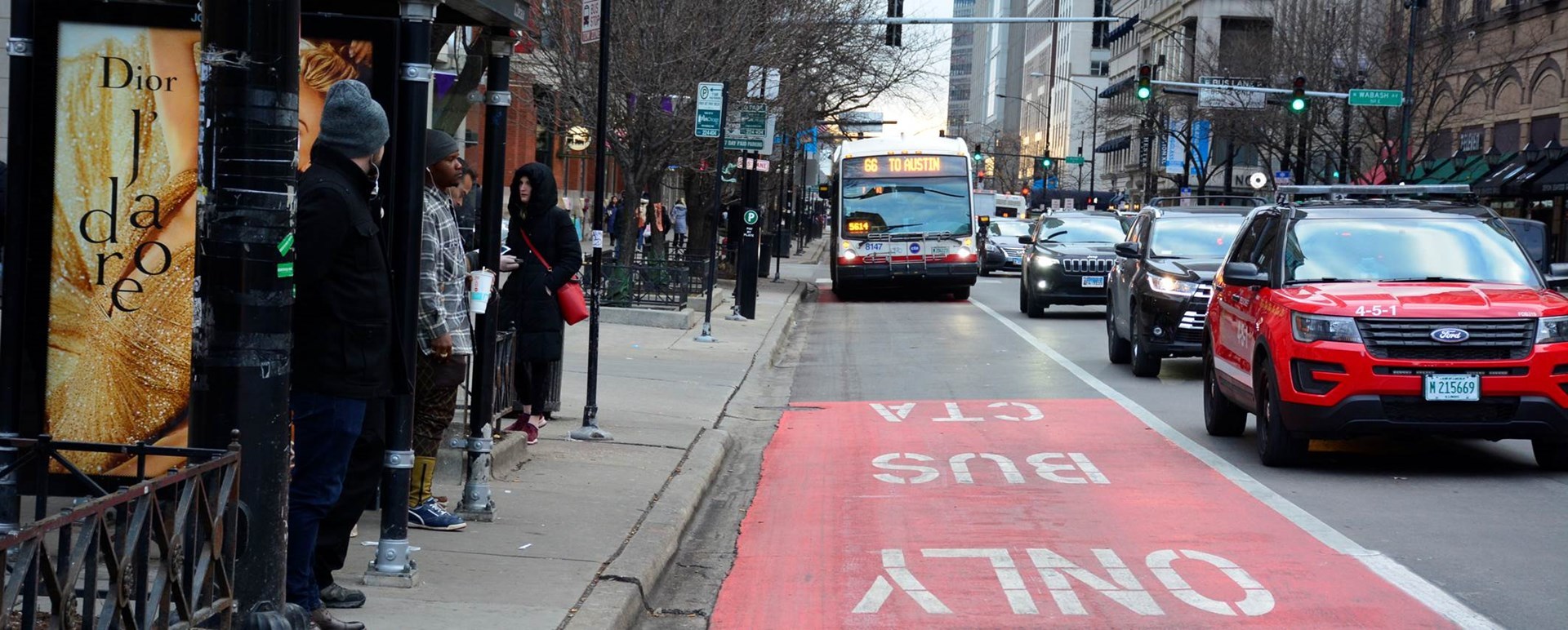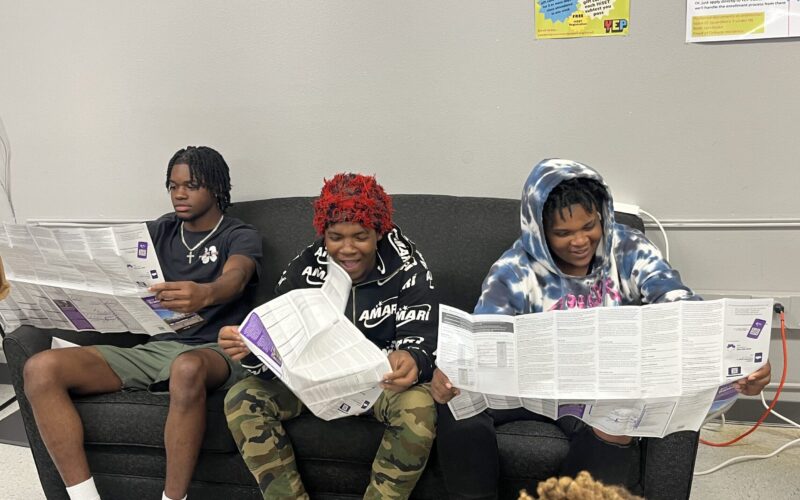
This post was written by guest contributor James Brasuell.
As cities across the country roll out center-running bus lanes, all-day busways, and bus shelter improvement programs, progress to improve Chicago’s buses has been painfully slow. Despite providing nearly twice the number of annual rides than Chicago’s rail system, the city’s buses slog through car traffic on streets that lack any obvious signs of high quality bus service. Bus shelters are few and far between, and very few examples of public rights of way dedicated to buses can be found anywhere in the city. What does exist is fleeting, in disconnected segments or only for peak hours during the day.
In April, the Chicago Transit Authority (CTA) and the Chicago Department of Transportation (CDOT) announced the first effort in years to significantly improve the plight of the city’s buses. The Better Streets for Buses plan, launched with $300,000 from the Chicago Metropolitan Agency for Planning, will lay the groundwork for reconfiguring city streets to improve bus service.
Along with a new organizing effort from Transit for All that aims to up the pressure on Mayor Lori Lightfoot and activate the transit workforce around bus improvements, this could be an opportunity to turn Chicago’s buses around. But it will only happen with focused and sustained organizing to disrupt the inertia that has beset the city’s political and bureaucratic machines.
Raising the Bus’s Profile
Over the past decade, Chicago’s largest transit ambitions have focused almost exclusively on improving the rail system. The CTA completed the Red-Purple Bypass project in 2021, adding a high-flying ramp for the Brown Line in the relatively affluent neighborhood of Lakeview to remove a key bottleneck in the CTA rail system.
The most ambitious effort in the past decade to remove bottlenecks for CTA bus service, on the other hand, fell apart in 2015 after years of planning. The Ashland Bus Rapid Transit (BRT) project would have added 16 miles of dedicated bus lanes on Ashland Boulevard, a key north-south axis through the city, long identified as an obvious fit for BRT. Former Mayor Rahm Emanuel, however, shelved the project indefinitely in response to vocal opposition from local business owners. Now, the only permanent bus priority infrastructure in the city can be found on short stretches of four adjacent streets in downtown called the Loop Link.
According to Audrey Wennink, director of transportation for the Metropolitan Planning Council (MPC), the performance of buses has suffered through this lack of planning and investment. “The speeds of our buses have gone down,” she said, adding that ridership was declining even before the pandemic.
Politically, buses have not been a priority. Mayor Lori Lightfoot has not directed city agencies to make any substantial bus improvements during her tenure, and the city council has historically lacked any consistent, vocal bus champions.
But ridership trends during the pandemic elevated the bus’s profile, and added some urgency to the need for improvements. Bus ridership has recovered to 56% of pre-pandemic levels while rail ridership has lagged, indicating their essential status to Chicago’s workforce.
“Everybody from elected officials to the media to residents now further understand the really essential value that bus service provides,” according to Kyle Whitehead, managing director of public affairs for Active Transportation Alliance, an advocacy group that has worked to put bus improvements on the transit agenda in Chicago over the last five years.
The efforts of Active Trans will soon be buoyed by a new organizing effort in the mix —a campaign called Transit for All, launched by Chicago Jobs with Justice, a nonprofit that supports workers’ rights and social and economic justice. The Transit for All coalition includes the bus drivers’ union, ATU Local 241, and other local unions. Executive Director Susan Hurley explains that because significant bus improvement has so far been difficult to achieve from the inside of City Hall, Transit for All is “going to be focused on organizing transit riders and working with the workforce.”
Better Streets for Buses
CTA and CDOT jointly announced the Better Streets for Buses outreach effort in April. “We know that Chicago relies on buses….Buses reach across all of our neighborhoods and for many it is their primary mode of travel,” said CTA President Dorval Carter in a statement announcing the plan. “CTA buses are accessible, affordable, and available throughout the city and improving bus service is key to achieving transportation equity in Chicago,” said CDOT Commissioner Gia Biagi in the same statement, also noting the equity goals for increased mobility laid out in CDOT’s Strategic Plan for Transportation.
Since then, the CTA and CDOT have hosted three public meetings, and launched an interactive website that allows residents to choose a new network of “bus priority streets” among 45 potential routes. The public can also rummage through a “Toolbox of Street Treatments” to vote for their preferences among options such as real-time travel info signs, covered shelters, and bus stop bump-outs. Curbside bus lanes, center lanes, and bike-bus combination lanes are also open for debate, though curbside bus lanes have historically been difficult to install in Chicago thanks to the city’s onerous parking meter contract.
Advocates worry that the way the outreach has been structured won’t lead to successful outcomes. Whitehead is concerned that the sheer number of options on the table at the Better Streets for Buses website could complicate the goal of developing a bus priority network. If, for example, CDOT and CTA prioritize a large number of small interventions instead of a small number of large interventions, BRT would likely be left out of the city’s bus improvement plans again, with little hope for future development. Wennink agrees with this risk assessment. “So often planning will do something halfway, nibble away, and then when it doesn’t work, it’s viewed as a failure,” she said. In a recent blog post for MPC, Wennink wrote that “while it’s good that CTA is seeking Chicagoans’ feedback, the challenge here is that if individual riders are asked what they want from a list of improvements, they are likely going to define an enhancement where they live or work and not along an entire corridor.”
In order to avoid this piecemeal approach, Chicago’s transit advocacy community is mobilizing to demand bus lanes and BRT from the process. Active Trans recently worked with the Environmental Law and Policy Center to release a petition calling on CDOT and CTA to implement five dedicated BRT corridors throughout the city over the next five years.
The Transit for All campaign intends to use the Better Streets for Buses conversation as a chance to organize workers and bus riders for transportation equity. “If you’re gonna get more and better results, the more people you mobilize,” says Hurley. “You need an escalating pressure, culminating with people in the streets and the workers in the system being willing to negotiate transit policy.” According to Hurley, workers should be prepared to take job actions in support of transit.
The Path Forward
Chicago should look to peer cities like Boston and New York to learn how to overcome political and technical obstacles to bus priority projects. The 14th Street Busway in New York City reduced bus travel times by 24%, and dedicated lanes across Boston and surrounding cities are increasing speed, reliability, and ridership. All of these projects navigated heated political controversy during the planning process, requiring leadership and persistence in the face of opposition. Since completion, these initiatives have been hailed as resounding successes. Both The New York City Department of Transportation and the Massachusetts Bay Transportation Authority are now building on those successes, and delivering a pipeline of bus priority projects throughout New York and Boston every year.
Whatever set of improvements emerges from the Better Streets for Buses process will necessitate the continued involvement and vigilance of transit advocates holding CTA and CDOT to clear, concrete goals. Implementing the recommendations will also require “mobilizing the existing coalitions in transit to put pressure on elected officials and the mayor directly to say, ‘you have to make this a priority,'” says Hurley. The political leadership in the city needs to hear this message, says Hurley because “we don’t know if there’s the political will to make those changes, either in the mayor’s office or at CTA.”
The implementation of the Better Streets for Buses plan will also require CDOT and the CTA to get clear about their funding priorities. In addition to the massive windfall of transit funding available from the federal Infrastructure Investment and Jobs Act (IIJA), capital spending plans at the state and local level have some capacity to fund BRT projects. But this won’t happen unless CTA and CDOT have a plan for what projects they need funding for. “It seems like there’s lots of funding available over these next few years,” says Whitehead. “We’re not sure how long that’s going to last, so we need an ambitious plan now.”
Time is already running out on this rare opportunity to improve bus service in Chicago—the public engagement process ends on June 10th. The opportunity to take advantage of unprecedented levels of funding from the IIJA also has an expiration date. “This is a window to actually get this stuff funded,” says Wennink about IIJA transit funding programs. “If we don’t do that within five years, then we’ve missed a huge opportunity.”
 On the Brink: Will WMATA’s Progress Be Erased by 2024?
On the Brink: Will WMATA’s Progress Be Erased by 2024?
The experience of being a WMATA rider has substantially improved over the last 18 months, thanks to changes the agency has made like adding off-peak service and simplifying fares. Things are about to get even better with the launch of all-door boarding later this fall, overnight bus service on some lines starting in December, and an ambitious plan to redesign the Metrobus network. But all of this could go away by July 1, 2024.
Read More Winning Free Fares for Youth in New Orleans
Winning Free Fares for Youth in New Orleans
Most transit agencies rely on fare revenue to fund operations, meaning many are forced into the position of needing to collect fares from the people who can least afford it. To change this paradigm, advocates across the country are fighting for - and winning - programs that allow agencies to zero out fares for youth, removing one of the largest barriers to youth ridership.
Read More